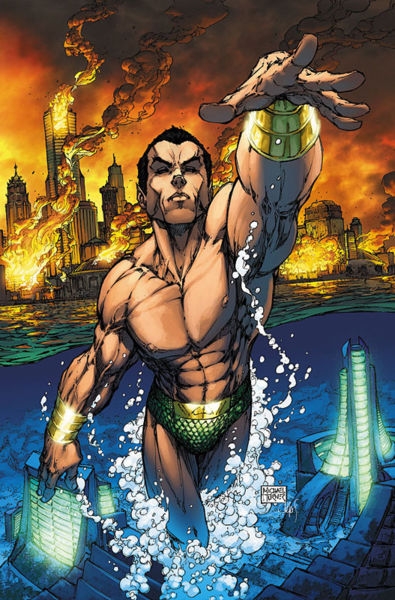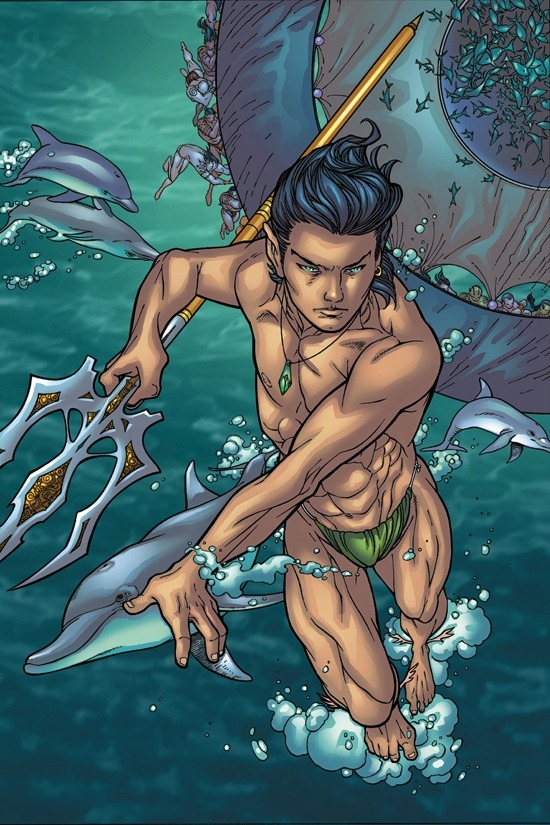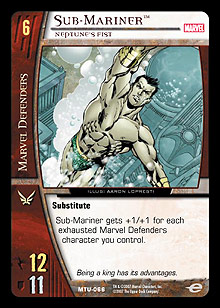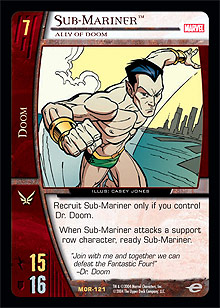
Welcome back to the tenth installment of Living Ink, my weekly series that focuses on the comic book characters that inspire our Vs. System cards.
This week, we’re going to dip a toe into the vast and deep ocean of Atlantean mythology in comics. To the casual, non-comic-reading observer, Marvel’s Namor and DC’s Aquaman may not seem like much. I mean, if you’ve seen one King of the Sea, you’ve seen them all, right?
While average guys around my age are arguably more likely to be familiar with Aquaman via his inclusion in the 1970s cartoon series Super-Friends, it would be a mistake to think that Marvel’s Namor is a knock-off of the orange-shirted super swimmer, or to assume that either character resembles the other in any way beyond superficial similarities.
Namor (a.k.a. the Sub-Mariner) is actually one of the oldest super heroes in existence, having first appeared in a promotional publication called Motion Picture Funnies Weekly in 1939 (two full years before Aquaman, who first appeared in DC’s More Fun Comics # 73 in November 1941). Namor’s first traditional comic book appearance was in Marvel Comics #1, which was the very first comic published by Timely Comics later in 1939. (Regular readers might recognize the name Timely Comics from my Captain America article. Marvel Comics started out as Timely Comics, and didn’t adopt the better known name until the early 1960s.) Namor was one of Timely’s most popular super heroes, alongside Captain America and the original Human Torch (an android that predated the Fantastic Four’s Johnny Storm).
Namor McKenzie is the son of a human sea captain and a princess of the mythical undersea kingdom of Atlantis. In addition be being a human-Atlantean hybrid, the Sub-Mariner is also a mutant. He possesses the super strength and aquatic abilities of the Atlantean race. He can also fly and telepathically control marine life, and he possesses electrical powers and an extended lifespan.

Aquaman’s history up to this point actually sounds quite similar. The Golden Age Aquaman was Arthur Curry, son of lighthouse keeper Tom Curry and Atlanna, a water-breathing outcast from the lost underwater city of Atlantis. Due to his heritage, Aquaman possessed various super-human abilities, including the ability to survive underwater, the power to communicate with sea life, and tremendous swimming prowess, which together place his power level a fair bit lower than his Marvel counterpart. Aquaman’s origin was revised in 1989, though, when the Legend of Aquaman Special established that he was the son of Queen Atlanna and the mysterious wizard Atlan, and was named Orin. Orin was abandoned on Mercy Reef as a baby because of his blond hair, which was seen by the superstitious Atlanteans as a curse. Raising himself in the wilds of the ocean, Orin was found and taken in by a lighthouse keeper named Arthur Curry who renamed him Arthur Curry. So, the modern incarnations of the two characters, as we see them today, are very different (and that’s not even taking into consideration that a brand new Aquaman is appearing in the current Aquaman: Sword of Atlantis series).
Through the years, Namor has been portrayed both as a good-hearted but short-fused super hero and a hostile invader seeking vengeance for perceived wrongs committed against his underwater kingdom by surface dwellers.* For this reason, it is argued by some that the Sub-Mariner is the first comic book anti-hero.

Namor’s mother, Fen, was the daughter of Atlantean Emperor Thakorr. Fen was sent to investigate an icebreaker captained by Leonard McKenzie. When his daughter failed to return, Thakorr assumed that his child had been captured and launched an attack. In fact, McKenzie and the Atlantean princess had fallen in love. During the attack, it appeared as though Leonard was killed. Fen returned to her kingdom, and nine months later gave birth to a pink-skinned child, which made him quite distinctive among the blue-skinned Atlanteans. Unlike Aquaman, though, he was not cast out for his differences.
In early appearances, Namor clashed with the original Human Torch, but he later teamed up with the same to fight the Nazis and the other Axis powers during World War II. A later retcon placed both characters in a collection of Golden Age super heroes, including Captain America, called the Invaders.
.jpg)
Namor first gained a solo feature in Sub-Mariner Comics in 1941. This was relatively short-lived, though, as the popularity of super hero comics slumped after WWII and some were cancelled. There was a brief revival for Namor in the mid-1950s, starting with Young Men #24 (which also briefly revived Captain America and the original Human Torch). He also appeared in Sub-Mariner Comics #33–42, published April 1954 to October 1955, but he disappeared from shelves once again after that.
Namor returned in Fantastic Four #4 in May 1962, where he was discovered as an amnesiac homeless man in the Bowery section of Manhattan. Johnny Storm dumped him into the river, which restored his memory and prompted him to return to Atlantis. Upon returning to his underwater home, though, he found only an outpost destroyed by nuclear testing and became enraged at the surface world. He commanded an army of sea creatures to attack the land-lubbers, which brought him into conflict with the Fantastic Four. During this battle, Namor developed a powerful crush on Sue Storm (a.k.a. the Invisible Woman). This was a torch he carried for many years to follow.
In Avengers #4, published in March 1964, Namor discovered an Arctic tribe worshipping a frozen figure preserved in a block of ice. Typically quick-tempered, Namor threw the block into the ocean in protest of the tribe’s “idolatry.” The ice melted to reveal the body of Captain America, perfectly preserved. The Avengers revived Cap and he joined the famous Marvel super hero team. In the following issue, Namor joined the Hulk in an attack on the Avengers, but was left high and dry when the temperamental Hulk abandoned the fight.
After a series of successful guest appearances, Namor was once again given a feature in the split-title comic Tales to Astonish, beginning with issue #70 in August 1965. He was then given his own solo series in 1968 entitled The Sub-Mariner. This title wrapped up in 1972.

Sometimes fighting on the side of right and sometimes on the side of wrong, Namor was affiliated with Magneto’s Brotherhood of Evil Mutants and the nefarious Dr. Doom at different stages. But perhaps his best known affiliation has been with the Defenders (first appearing in Marvel Feature #1 in December 1971), a team comprising an ever-evolving roster of heroes but retaining Dr. Strange, the Silver Surfer, the Hulk, and Namor as a consistent core.
At one point in Namor’s ongoing tale, he was found nearly mad in the South Pacific by a father and daughter oceanographer team who nursed him back to health. The father had long theorized that Namor’s rage was caused by his half-human, half-Atlantean blood chemistry. He equipped Namor with a monitor to warn him when to seek either air or water. This allowed Namor to control his metabolism for the first time. Determined to continue to preserve the oceans and his people in secret, Namor collected sunken treasures to finance his purchase of a corporation he renamed Oracle, Inc. Under the guise of an international businessman, he supported environmental causes.* This continued for a while, but soon enough, he was forced to reveal himself to avert a disaster.
Namor later returned to Atlantis to deal with border attacks by the “Faceless Ones.” After Fen attempted to usurp the throne, it was revealed that she was actually the witch-queen Artys Gran, who had stolen Namor’s mother’s body. Namor was killed battling Gran’s sorcerer-king husband Suma-Ket, but was later revived by Father Neptune, the deity worshipped by Atlanteans. In the process, Namor was given the sacred golden armor of his ancestor, with which he defeated Suma-Ket’s forces. The real Fen, trapped in Gran’s body, died defending her son from an attack. Namor returned to both ruling Atlantis and running Oracle, Inc., but has since remained generally out of the surface world. Oracle Inc. began funding the charitable super-group Heroes for Hire.*
.jpg)
Most recently, Namor has appeared as a member of The Illuminati, a clandestine policy group comprised of some of the key leaders in the Marvel universe. He left this group, though, in protest of its decision to exile the Hulk, the results of which led to the recent “Planet Hulk” storyline. Namor’s cousin Namorita was then killed in the explosion by the super villain Nitro, which led to the events shown in Civil War. This led the Illuminati to ask Namor back, but Namor quickly found himself in conflict with key members yet again because he opposed the Registration Act. At the end of Civil War, Namor brought an army of Atlanteans to aid Captain America’s forces, but the conflict was ended when Captain America surrendered to protect innocent lives.
It has been announced that the Sub-Mariner will receive a new six-issue miniseries this year with a story spinning off from the events of Civil War.
There have been six versions of Namor (all named Sub-Mariner) in Vs. System to date.

Sub-Mariner, King of Atlantis is a 3-drop Marvel Defenders character from the
Marvel Team-Up set. Supporting the Defenders’ exhaustion theme, all of your other characters become exhausted whenever this Sub-Mariner attacks. I don’t know if it was intentional (although I bet it was), but I like the way this effect is suggestive of all of your other characters kneeling before the King of Atlantis. This card also has a relatively large ATK, demonstrating Namor’s naturally aggressive personality and strength in combat.
Sub-Mariner, Illuminati is a Doom affiliated 4-drop from the Heralds of Galactus expansion. This obviously represents one of the times when Namor entered an uneasy alliance with the Latverian dictator. His deck-manipulating effect is themed similarly to the other Illuminati characters, and demonstrates the power of knowledge. The Illuminati is a council of influential heroes that gathers to share information and set the course of world affairs; how better to represent such power in Vs. System than to give a player increased access to the cards in his or her deck and the means to control which cards are drawn on future turns? Sub-Mariner’s effect also supports Doom’s Army recursion theme, which is similarly appropriate for Namor, who controls the armies of Atlantis.
Sub-Mariner, Atlantean Monarch is perhaps the least-known character in this list, since he appeared as a Doom 5-drop in the Fantastic Four Starter. The most flavorful aspects of this card are the artwork and, not surprisingly, the flavor text. The artwork pays homage to Namor’s long-running infatuation with the Fantastic Four’s Invisible Woman. The flavor text also points out the Sub-Mariner’s changeable nature; when he turns up, you never really know if he is going to be an ally or an enemy.

Sub-Mariner, Namor is a 5-drop legacy character for the Avengers team that was printed in The X-Men. As both a reservist and a leader, Namor was a welcome addition to the Avengers roster for players wanting to support both of those themes in their deckbuilding. All of this is perfectly in flavor, as well, as being king of an underwater empire does require strong leadership ability.

Sub-Mariner, Neptune’s Fist, a 6-drop Marvel Defender from Marvel Team-Up, is a nice progression from the previously discussed 3-drop. Once again, I think his power represents kneeling subjects, but this time, Sub-Mariner gets a big boost depending on the number of supporting characters in play. This is a perfect example of flavor and mechanical themes being fused together to give players the best of both worlds—flavor and function.

Sub-Mariner, Ally of Doom is a 7-drop Doom character from the Marvel Origins set, and was one of the original powerhouses of the game. Combined with The Power Cosmic, Ally of Doom was the number one reason why you had to form up with all of your characters in the front row, even when you had the initiative, when playing against a Doom player. Highlighting Namor’s ability to fly, his aggressive nature, and his prowess in combat, Ally of Doom remains one of the most all-around enjoyable cards in the game.
Usually, I provide a recommended reading list at the conclusion of these articles, but sadly, Namor has not received as much love as some other characters in terms of being reprinted in collected editions. This will make it very hard for new readers to access classic tales of Namor’s adventures. For this reason, I’m not going to provide an extensive reading list, as I wouldn’t want to send anyone on a frustrating wild goose chase. I do recommend, though, that you check out reprints of The Defenders (classic stories reprinted in three volumes of Essential Defenders and the more recent storyline reprinted in Defenders: Indefensible TPB), as well as the Namor miniseries that will be published this year.
See you in the funny pages,
Michael Pittman
ikeebear@hotmail.com
* from Wikipedia.com